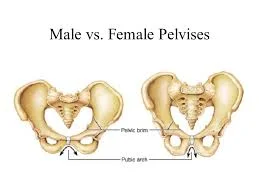During each new patient evaluation, there comes a time when we talk about the pelvic floor, its anatomy, and how it works.
And this is my FAVORITE part. Each time. Without fail.
Why?
Because learning about the pelvic floor is eye-opening! We get potty trained at an early age and then take peeing, pooping, and sex for granted until something goes wrong.
Learning about the pelvic floor can help prevent issues and help you understand treatment options if you do have problems!
What Is The Pelvic Floor?
The pelvic floor is a group of muscles at the bottom of your torso that attach to the pelvis.
These muscles surround your urethra (where pee comes out), vagina or penis, and anus (i.e. butthole).
We all have three layers of pelvic floor muscles, each with specific jobs.
Here is a side-by-side view of the pelvic floor muscles which shows us that there are more similarities than differences in anatomy!
This view is from the bottom up with the skin removed, like if you were laying on a table in stirrups.
Where Is The Pelvic Floor?
The pelvic floor muscles attach to the pelvis, also known as the pelvic girdle.
The pelvis is a bony ring made of the hip bones, sit bones, sacrum, and tailbone (e.g. coccyx). The pelvis attaches to the lower back (e.g. lumbar spine) and to both of the legs.
The pelvis allows us to move our legs and protects the internal organs (including the bladder, rectum, intestines, and genitals) while supporting the weight of our upper bodies!
The pelvic floor muscles attach to the inner walls of the pelvis.
What Do The Pelvic Floor Muscles Do?
These muscles have several important jobs!
Peeing and Pooping
The pelvic floor muscles wrap around the urethra and anus. When they contract, they close these openings, meaning no pee or poop comes out.
When it is the right time to go, the pelvic floor muscles relax, opening the gates. Pee and poop are actually pushed out by automatic contractions of the bladder and rectum, respectively, not the pelvic floor muscles.
I'm going to say that again: do not force your pee and poop out! That's not how it works!
🚨 If these muscles do not contract when they are supposed to you can experience urine leakage, passing gas unintentionally, queefing, or fecal leakage. If the muscles do no relax properly when you are trying to go to the bathroom you will have pain, constipation, straining, or incomplete emptying.
Satisfying Sex
The pelvic floor muscles surround our genitals and play a role in sex.
For people with vaginas, these muscles keep the clitoris erect, provide tension around the vagina, and contract during orgasm.
For people with penises, the pelvic floor muscles maintain erections and assist in ejaculation by contracting during orgasm.
🚨 Issues can come up if the pelvic floor muscles are too tense, often causing pain and/or issues with penetration.
Supporting Organs
The pelvic floor is like a hammock at the bottom of our trunk and it cradles all of our internal organs. These organs are also attached to our body by connective tissues and ligaments, so it’s not all on the pelvic floor.
💡 Did you know? Working on pelvic floor strength, endurance, and coordination is the #1 treatment recommendation for pelvic organ prolapse.
Core Stability
The pelvic floor is one part of “the core.” It works with your diaphragm, back muscles, and transverse abdominis to support your body as you sit, stand, and move around.
These muscles are always working to some extent and kick in more when needed, like when you’re lifting your toddler or running.
💡 Did you know? Research shows that people with low/hip/abdominal pain have issues with core coordination and endurance. Training the pelvic floor as part of your core is often overlooked!
Improving Circulation
Last, but not least, when the pelvic floor muscles contract, they help increase circulation through the pelvis. This is especially helpful during pregnancy when there is more fluid in the body.
The pelvic floor “bottom line”…
These muscles are essential to what we do every day and we often take their function for granted until something goes wrong!
Do you suspect that you’re having pelvic floor issues?
Sign up for a free pelvic floor discovery call!
Expert Pelvic PT
Dr. Monika Eddings, DPT, WCS (she/her) has over 8 years of experience seeing hundreds of patients. She is one of only 400 board-certified Women’s Health Clinical Specialists in the United States.
Dr. Monika specializes in helping people overcome issues with peeing, pooping, sex, pelvic pain, and postpartum recovery.
Resources:
Evidence-Based Physical Therapy for the Pelvic Floor, 2nd Edition (2015)












